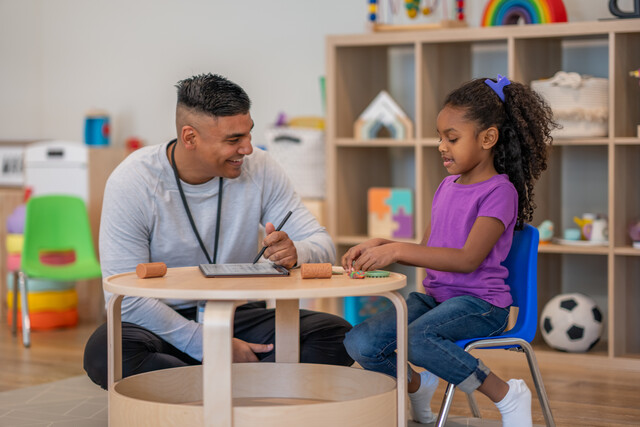It is important to understand how to properly introduce yourself and how to introduce others. For some, polite forms of greeting are natural, but for most people, particularly children and teens, mostly because they are unfamiliar with the ritual, it is an awkward, uncomfortable situation for young people. It need not be. With a little guidance and a lot of practice, greeting others will become comfortable and natural and will make others feel comfortable being around you.
How to introduce yourself
When meeting someone for the first time, look him or her in the eyes with a non-challenging, friendly gaze and simply start with "hello/hi, my name is __________." Provide some information about yourself, with your name as a point of reference. Use the setting to guide you. If you are at a gathering with your parents and you are meeting adults, children, or teens who know them, introduce yourself as their child. "Hi, my name is Mary; I'm William and Judith Bartholomew's daughter/son." If you are at a school event, then be sure to mention what grade you are in and who your teacher is. "Hi, my name is Mary, I'm a 7th grade student here; my teacher is Mrs. Rupp." Allow the person time to reply with his or her name and some information about themselves. Respond to inquiries politely, and listen when the person speaks to you. If he or she asks a question that you don't know the answer to, direct them to an adult who can answer their question.
The other party will usually respond by giving his or her name. After the "formal" name and brief information exchange has taken place, you should initiate an "ice breaker." An ice breaker is more information about yourself, or a question to the other person that engages them in a brief conversation. If they haven't given you enough information about themselves, use a general question for your ice breaker. Here are some examples:
How are you enjoying the party/event/gathering?
How do you know _________________?
Do you live in the area?
Discussing sports, music, personal hobbies or interests, school information, and/or current events and news are all good things to talk about with strangers. Stay away from controversial topics, and don't ask or offer very personal information. It is considered rude to ask strangers prying, personal questions. Keep first introductions light and easy. Keep in mind, that even if you have met someone several times, asking or offering very personal negative information is inappropriate and usually makes people uncomfortable.
How to introduce someone else
Whenever you are in the company of people you know, who do not know each other, you should introduce them to each other. Consider yourself a good will ambassador in these situations. For example, if you are at a movie with a friend and you run into a group of classmates, you should introduce your friend to your classmates. You could say something like the following:
"Laura and Teresa, this is my friend Madison, she plays basketball with me. Madison, these are my friends from school, Laura and Teresa."
When introducing yourself to someone your own age or younger, a handshake may seem too formal; let your good judgment be your guide. A simple, "Hello, my name is___________," works well for those your own age. It is still appropriate to provide some information about yourself, as explained in the "Introducing yourself" section, and to give an ice breaker by asking the person your own age a question or two about themselves.
How to greet family, friends, and guests
Conversation and Listening Skills
Introduction
This article will focus more on how to start, continue, and end a conversation. A good conversation has many purposes. It allows you to get to know others better, it helps them get to know you better/ It gives you different views and opinions, and provides a wealth of information. Conversing with close family and friends is not addressed here because rules of "etiquette" do not apply to those we are close to. However, there is certain etiquette to follow when conversing with anyone other than close friends and family members.
How to start a conversation
When getting to know anyone, it is best to start a conversation with a general question about the other person. It is also good to provide information about yourself, your interests, and your life. Often, once these general bits of information are passed between people, a commonality is established. For instance, you may mention that you enjoy basketball, the other person tells you they also really enjoy the sport. The conversation can flow and develop from that one common interest. Most people like to talk about themselves or their interests. The key that unlocks the door of conversation is asking the right questions that will get a person talking, then finding something you have in common to discuss. Try different questions until you find one that gets a conversation going.
Some people are easy to talk to, while others are not. When dealing with those who are shy, reserved, or just quiet, don't push them too hard to converse. Ask them a few general questions about themselves and see if that breaks the ice. If not, offer some information about yourself and see if that gets them talking. If they still don't seem interested in talking. Let it go. Don't ever force someone to talk to you, or make them feel uncomfortable for not doing so. Most importantly, be kind. The person may be having a bad day, or have a personal issue, or is just very shy. Do not take it personally and do not insult the person for not speaking with you. Politely excuse yourself, and meet someone else who prefers to talk.
What topics, and which situations, to avoid
There are some topics that are off limits -- basically, any topic that would make another person uncomfortable. A good general rule of thumb is, "if it would make you uncomfortable, angry, or annoyed" if the topic were brought up to you, then chances are it will make the other person uncomfortable, annoyed, or angry too. If you are an easy-going type, don't assume that others are as easy going, too. For instance, you may be fine discussing the cons of private schools, even if you attend one, but someone else may not want to hear negative comments about the school they attend. "Touchy" or potentially dangerous subjects often involve negative comments about religion, politics, and ethnicity. These are personal, highly charged topics that are best saved for someone who knows you better. Someone who does not know you may misunderstand your comments.
Getting others involved in a conversation
If you are having a conversation, and another person joins you, it is good etiquette to get them involved in the conversation. If you are talking, pause to greet the new person and say, "Hi Madison, we were just talking about last night's basketball game," then finish your conversation or let Madison add her input, too. If another person was talking, wait for him or her to pause, and invite the other person/people into the conversation by telling them what you were talking about. If you were talking about something the new person does not know anything about, change the subject to something that would include them.
Ending or changing a conversation gracefully






























